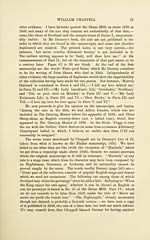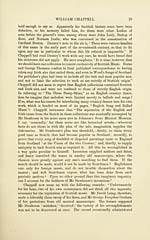Inglis Collection of printed music > Printed text > Early Scottish melodies
(44) Page 22
Download files
Complete book:
Individual page:
Thumbnail gallery: Grid view | List view

22 EAJfcLY SCOTTISH MELODIES.
from his index " Let never Crueltie dishonour beauty," while at the same
time " The Nightingale" was not included in his own index to " The
Popular Music of the Olden Time."
In answer to Chappell's arguments, we have to say, (1) It has not
been proved by him that the Skene Manuscripts, or part of them, were
written after 1640, — though David Laing expressed his opinion that
they should probably "be considered as ten years subsequent in date,
either to 1615 or 1620," to which Dauney assigned them. (2) Mr
Dauney did not profess to give all the airs from the Skene MSS., nor
to place them in any particular order, and no doubt he considered
it unnecessary to print any duplicates. (3) The index printed in his work
is that of the manuscripts (not of the melodies he has given), and it is
practically complete, barring the solitary omission, and the indelicate titles
of two other tunes. (4) The statement that all the writing in Part II.
is a century later than the tune " Lady wilt thou love me," given at
the commencement, is pure conjecture. (5) Chappell, in introducing
what he calls " the large number of duplicates," (nine) as evidence of the
improbability of the collection having been made for one person, decidedly
shews want of " some care " when examining the manuscripts, otherwise
he would have seen, had he understood the tablature, that the airs were
only transposed into other keys, or had an altered fingering ; which proves
his supposition to be worthless. (6) The fact that " Adieu Dundee " is first
printed in "The Dancing Master" appendix of 1688, " The Three Sheep-
Skins" in "The Dancing Master "of 1698, and that he does not believe
"Peggy is over the sea with the Soldier" to be older than 1710, does
not disprove the existence of these tunes in manuscripts of earlier dates,
nor does it show that they were copied from these sources.
Chappell's sole test in judging such matters was apparently " The
Dancing Master." He says, " When Dauney expressed his opinion that the
sixth was the oldest part, he was evidently deceived by the shape of
the (lozenge shaped) note," and further, that " The Scotch adhered to
old notation longer than the English, especially in writing music on
six lines." This reference to music written on six lines has no bearing
on any tablature whatever ; that of the Skene consists of four lines only ;
again, Dauney's observations were not confined to the shape of the
note, but included, in addition to other evidence, " the appearance of the
paper, besides which it looks as if it had been penned by a different and
an older hand." From what we have already mentioned, we think the
following advice given by Mr Chappell is quite superfluous : " I leave
it to Scottish antiquaries to determine whether corroborative evidence
of the date of the manuscripts may not be found among the titles of their
own airs. Mr Dauney even passed over ' Leslei's Lilt' without a
suspicion that it derived its name from the Scotch general in the civil
wars." Judging from his former argument, Chappell wished it to be
believed that the MSS. were not older than 1710, though he was not
from his index " Let never Crueltie dishonour beauty," while at the same
time " The Nightingale" was not included in his own index to " The
Popular Music of the Olden Time."
In answer to Chappell's arguments, we have to say, (1) It has not
been proved by him that the Skene Manuscripts, or part of them, were
written after 1640, — though David Laing expressed his opinion that
they should probably "be considered as ten years subsequent in date,
either to 1615 or 1620," to which Dauney assigned them. (2) Mr
Dauney did not profess to give all the airs from the Skene MSS., nor
to place them in any particular order, and no doubt he considered
it unnecessary to print any duplicates. (3) The index printed in his work
is that of the manuscripts (not of the melodies he has given), and it is
practically complete, barring the solitary omission, and the indelicate titles
of two other tunes. (4) The statement that all the writing in Part II.
is a century later than the tune " Lady wilt thou love me," given at
the commencement, is pure conjecture. (5) Chappell, in introducing
what he calls " the large number of duplicates," (nine) as evidence of the
improbability of the collection having been made for one person, decidedly
shews want of " some care " when examining the manuscripts, otherwise
he would have seen, had he understood the tablature, that the airs were
only transposed into other keys, or had an altered fingering ; which proves
his supposition to be worthless. (6) The fact that " Adieu Dundee " is first
printed in "The Dancing Master" appendix of 1688, " The Three Sheep-
Skins" in "The Dancing Master "of 1698, and that he does not believe
"Peggy is over the sea with the Soldier" to be older than 1710, does
not disprove the existence of these tunes in manuscripts of earlier dates,
nor does it show that they were copied from these sources.
Chappell's sole test in judging such matters was apparently " The
Dancing Master." He says, " When Dauney expressed his opinion that the
sixth was the oldest part, he was evidently deceived by the shape of
the (lozenge shaped) note," and further, that " The Scotch adhered to
old notation longer than the English, especially in writing music on
six lines." This reference to music written on six lines has no bearing
on any tablature whatever ; that of the Skene consists of four lines only ;
again, Dauney's observations were not confined to the shape of the
note, but included, in addition to other evidence, " the appearance of the
paper, besides which it looks as if it had been penned by a different and
an older hand." From what we have already mentioned, we think the
following advice given by Mr Chappell is quite superfluous : " I leave
it to Scottish antiquaries to determine whether corroborative evidence
of the date of the manuscripts may not be found among the titles of their
own airs. Mr Dauney even passed over ' Leslei's Lilt' without a
suspicion that it derived its name from the Scotch general in the civil
wars." Judging from his former argument, Chappell wished it to be
believed that the MSS. were not older than 1710, though he was not
Set display mode to: Large image | Transcription
Images and transcriptions on this page, including medium image downloads, may be used under the Creative Commons Attribution 4.0 International Licence unless otherwise stated. ![]()
| Special collections of printed music > Inglis Collection of printed music > Printed text > Early Scottish melodies > (44) Page 22 |
|---|
| Permanent URL | https://digital.nls.uk/94643800 |
|---|
| Description | Scottish and English songs, military music and keyboard music of the 18th and 19th centuries. These items are from the collection of Alexander Wood Inglis of Glencorse (1854 to 1929). Also includes a few manuscripts, some treatises and other books on the subject. |
|---|
| Description | The Glen Collection and the Inglis Collection represent mainly 18th and 19th century Scottish music, including Scottish songs. The collections of Berlioz and Verdi collected by bibliographer Cecil Hopkinson contain contemporary and later editions of the works of the two composers Berlioz and Verdi. |
|---|

